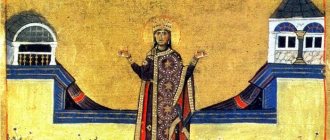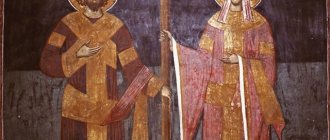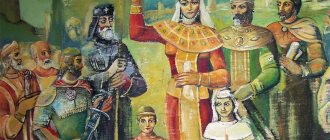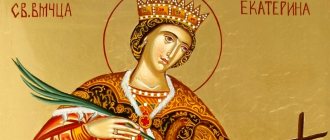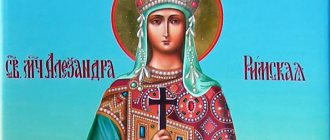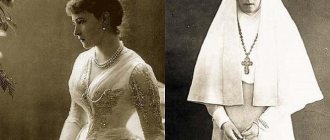There have been legends about the beauty, intelligence and charm of this woman for many centuries. The Queen of Georgia was glorified in poetry and poems, artists captured her face on their canvases. The hand of the beautiful Tamara was sought by noble nobles: the prince, the sultan and the shah. One of the best periods in the history of the country is associated with the Great Queen. Many historians consider the time of her reign to be the “golden age” of Georgia.
Tamara's childhood
The girl was born into the noble Bagration dynasty, her father was George III, and her mother was Queen Burdukhan of Alania. To celebrate, in honor of the birth of his daughter, George III ordered the construction of the Church of the Nativity of the Virgin Mary. It still stands in Tbilisi today, only it is called the Church of Our Lady of Didubi.
Tamara’s mother died early, and therefore the highly educated mentor Rusudan was in charge of her upbringing. The court lady gave the future ruler an excellent upbringing and education. Already at a young age, the girl had a talent for science, an extraordinary mind and curiosity.
Reign
Great Tamara ruled the country for about 30 years. The Georgian queen went down in history as the only woman in the world to bear the title of king. The years of her reign were marked by the rapid development of culture, the spread of Christianity, and the construction of temples and fortresses. King Tamar was a fair and wise ruler. A man's mind was combined in her with a woman's compassion.
The Georgian Queen Tamara did not ascend to the throne immediately; at first she was crowned as a child (according to various sources at the age of 12-14 years) as her father’s co-ruler. This was a necessary measure, because at that time the situation in the country was extremely turbulent: there was a rebellion of Prince Demna (nephew of George) and the Orbeliani clan. At this time, the king did not have a legal heir, so he made the wise decision to make his daughter his successor.
After the death of her father in 1184, Tamara was re-crowned in the Gelati monastery. From the very first days of her reign, the queen began to restore order in the activities of the church, and significant reshuffles took place in the government. She freed the churches from duties, restored internal peace in the country and greatly eased the lot of the peasants. She carried out reforms in the troops and waged wars of conquest in order to expand the borders of the state. The great queen often used the spoils of war to donate to temples and build new churches in the country. She abolished the death penalty in the country.
Major achievements during the reign of Queen Tamara:
- Improved the army;
- Expanded the borders of the state (Erzurum, Temriz);
- Defeated the Sultan of Ardabil;
- Won the Battle of Shamkor;
- Defeated the Aleppo Sultan Nucardin;
- Contributed to the development of the Georgian language and romantic literature;
- Spread Christianity among the mountaineers of the Caucasus;
- It showed the military power of the country and raised the authority of Georgia in the world.
After the death of the Great Ruler, the country quickly lost its power. First came the Mongol-Tatar yoke, and then the Turks conquered Georgia.
Prayers to the icon of Tamara
Troparion of Blessed Tamara, Queen of Georgia
Voice 8
Desiring the highest beauty, / the lowest sweetness of the body, you turned away from yourself / and in the royal demon / conveyed angelic life, / blessed Queen Tamaro, / pray to God God that our souls may be saved.
Voice 4
In the wonderful saints, / Iberia shone, / the blessed Queen Tamaro, / erected high temples on the mountains, / so that prayers were offered to the Lord in them, / with your prayers the fortress gave the howl of Christ - the loving people of the land of Iveron, / with the right hand the overturned hordes of Agarians / pray to God Christ / save our souls.
Prayer to the Holy Blessed Queen Tamara
O holy, great and blessed Queen Tamara! We are sinners (name) and humble, as if a warm protector and ambulance diligently came to us, asking for help and intercession in the abyss of abandoned problems, because every day and now we are obsessed with evil people and various diseases of the world, but your intercession, if great, have courage before God, pray for us in the sufferings, needs and misfortunes of those who are, and protect us from all visible and invisible enemies, especially from demonic cunning and cunning, impudent attacks and flattery yes, come, do not let us mock and mock them, and with your strong help drive them away from us, as you drove them out of the land of Iveron, and confirm in our hearts the faithful love of God and make me worthy.
When our departure from this temporary life and our migration to eternity is ripe, the freedom of the enemy will soon come to our aid from the violence of the enemy, as if you had eternal life, and lead our hearts to true repentance. And we will seem like the Holy Trinity with the dirty with lips and a clear conscience, glorifying and singing Yu, with all the saints forever. Amen.
Personal life of the Georgian ruler
The Georgian nobility was very unhappy that the country was ruled by a woman and therefore tried to get her married as quickly as possible. In 1185, a merchant was sent to Rus' to find a suitable groom for Tamara. He chose Georgy (Yuri) Bogolyubsky (grandson of Yuri Dolgoruky).
But the young couple did not have a happy family—the husband drank and led a dissolute lifestyle. And after 2.5 years, the queen was forced to send him into exile to the city of Constantinople. After the dissolution of the marriage, the offended George and his army went to Georgia in 1191 to regain the lost throne. He managed to occupy Kutaisi and was crowned there, but then the rebellion was suppressed and Yuri was expelled again. Despite this, the defeated ex-husband later made another attempt to take away the Georgian throne.
The second husband of Queen Tamara was her childhood friend and pupil of the same Rusudan, the Alan prince David Soslan. This time the girl chose her betrothed herself. This marriage was happy and gave the couple two children: son George IV Lasha and daughter Rusudan. The names of the children were not chosen by chance: the boy was named after the illustrious grandfather, and the daughter was named after the beloved mentor of the mistress. Her husband David was Tamara’s friend and comrade-in-arms on military campaigns for many years. Together they brilliantly won major battles and pursued an aggressive foreign policy. The woman survived him only by a few years.
Holy Queen Tamara the Great
2013 was declared by His Holiness Patriarch-Catholicos of All Georgia Ilia II the year of Queen Tamara, for, according to most historians, 800 years have passed since this amazing holy ruler of Iberia passed away to the Lord. The Pravoslavie.Ru portal presents a biography of the holy Queen Tamara, prepared based on extremely interesting Georgian chronicles.
The Holy Blessed Queen Tamara (in the center), her son King George IV and father King George III. Fragment of a fresco from the Betania monastery
In Georgia, the people have exceptional love for two holy wives - Equal to the Apostles Nina and the blessed Queen Tamara[1]. Over the centuries that have passed since her death, this love has not weakened at all, and cannot weaken, for Saint Tamara not only exalted Georgia during her earthly reign, but even after her death she only multiplied prayers for her suffering homeland, which was plunged into ruin for many centuries. into the unbearable horror of the Islamic yoke. The very reign of the blessed queen became a real miracle and a gift for Georgia, since it was in this fragile, unusually beautiful woman that the Georgians found their best ruler, fair and merciful, not femininely wise, but angelically judicious. And most importantly, it was in her that they found an eternal, vigilant prayer book and representative at the Throne of God until the Last Judgment.
Two major works have survived to our time, in which the holy queen’s contemporaries describe her life and reign. The first of them - “The Life of the Queen of Queens Tamar” [2] - was written, according to the most authoritative Georgian researchers, by a close associate of Queen Basili Ezosmodzgvari [3]. In this work, attention is paid primarily to the moral character of the saint, which, in fact, should be most consistent with the hagiographic genre. Another work, “History and Praise of the Crowned Men”[4], was written by a man more secular in spirit than the author of “The Life of the Queen of Queens,” but also an eyewitness to most of the events he describes[5]. It is replete with detailed geographical information, descriptions of battles and state councils. Together, both of these works recreate the life of the era in question in sufficient detail. All other information about the life of Saint Tamara is contained in separate surviving decrees and documents like deeds of gift. Fortunately, both works were translated into Russian in the first half of the 20th century, so we can rely on primary sources, detailed information about which can be read in the relevant articles[6].
The Life of the Holy Blessed Queen Tamara
Childhood and youth
Holy Blessed Queen Tamara Holy Queen Tamara (1166–1213)[7] came from the Bagratid family, which, according to established Georgian tradition, is usually traced back to the descendants of King David. The author of “History and Praise of the Crowned Bearers” at the very beginning of his narrative writes that he will “broadcast “praise of praise” to the one who descended from the seed of Solomon”[8], for she “fully corresponded to her ancestors - the Davidids, Khosrovids and Pankratids” [9].
The father of Saint Tamara was the “king of kings” George, the grandson of the famous saint David the Builder[10]. He fought a lot with the Mohammedans. Under him, the borders of Georgia were further expanded, so that “the Greek, Alemannic in Jerusalem, Roman, Indian and Chinese kings brought him gifts and fraternized with him; the sultans of Khvarasan, Babylon, Sham, Egypt and Iconium served him”[11]. Burdukhan, the mother of Saint Tamara, was beautiful and smart. From such parents came the one who was to become the adornment of Georgia, and indeed the entire Mediterranean.
In 1178, George, having gathered representatives of his seven kingdoms[12], with the consent of the patriarchs and all bishops, nobles, military leaders and generals, declared Tamara queen.
7 years later, on Holy Week of 1184, the father died, and representatives of the highest nobility came to Tamara so that she, being “mind conscious, intelligent and knowledgeable”[13], would take the kingdom into her own hands. The author of “Life...” describes the young queen this way: “Properly built body, dark eye color and pink color of white cheeks; a shy look, ... pleasant language, cheerful and alien to any swagger, speech that delights the ear, conversation alien to any depravity”[14].
Two marriages and confirmation on the throne
From the very beginning of her reign, Tamara showed remarkable intelligence, being concerned, first of all, with electing the most worthy persons to the positions of viziers[15] and military leaders. During this time, Tamara provided the bishops with donations, freeing the churches from dues and taxes. According to the chronicler, “during her reign, farmers became aznaurs[16], aznaurs became nobles, and the latter became rulers”[17].
She made Antony Glonistavisdze from Gareji and two sons of Amirspasalar[18] Mkhargrdzeli: Zacharia and Ivane as her close associates. Although they were Armenians by faith, they highly revered Orthodoxy, so that one of them, Ivane, subsequently “understood the crookedness of the Armenian faith, crossed himself and became a true Christian.”[19] In the future, all these people will show their best sides.
However, not everyone appreciated the tenacious mind of the young queen. Some of the senior officials conspired to rise even higher and not to let new associates higher up the career ladder pass. Minister of Finance Kutlu-Arslan openly proposed creating some kind of parliament that would deal with the affairs of government, and Tamara’s power would be reduced only to the formal approval of all the laws they adopted. The queen detained the minister, the military stood up for him, but through negotiations the situation was resolved[20].
In 1185, by unanimous decision of the Patriarch, bishops and courtiers, it was decided to find a husband for young Tamara. For this purpose, the merchant Zerubbabel was sent to Rus', “due to the belonging of the Russian tribes to Christianity and Orthodoxy”[21]. Arriving in Rus' and meeting George, the son of the holy martyr Andrei Bogolyubsky, “a valiant young man, perfect in physique and pleasant to contemplate”[22], Zankan brought him to Georgia. Everyone approved of the groom’s choice, but Tamara, judicious beyond her age, said: “How can you take such a rash step? Let me wait until you see his advantages or disadvantages.”[23] But the courtiers insisted on their decision, forced her consent and arranged a wedding.
A little later, Tamara’s fears were justified: our compatriot, alas, proved himself to be a drunkard who committed “many indecent things”[24]. For two and a half years the saint endured her husband’s vices, addressed him through worthy monks, and then she herself began to denounce him face to face. But George became even more furious and began to commit more destructive offenses. Then Tamara, “shedding tears, sent him into exile, providing him with untold wealth and jewelry”[25]. In 1187, George settled in Constantinople.
Thanks to her natural beauty, intelligence and charm, the saint became a desired bride for many kings and princes from all over the world. The eldest son of the Byzantine emperor Manuel almost went crazy because of her. Several sultans were ready to betray Islam just to win her hand. But Tamara remained adamant, because. Due to her innate craving for purity, she generally wanted to remain celibate.
However, the courtiers were worried about the lack of an heir, and only for his sake did the saint agree to marry the Ossetian prince David, a pupil of her aunt Rusudan, in 1188. This marriage turned out to be successful. In David, Saint Tamara found a wonderful husband and a fearless military leader. Contemporaries said about his abilities that “this David, within one year, surpassed everyone in everything that comes from the hands of man”[26]. Soon Tamara gave birth to an heir, whom she named after her grandfather George, and then a daughter, whom she named after her aunt - Rusudan.
Having learned about the marriage of Saint Tamara, the Russian prince decided to compete for the lost throne. He left Constantinople and came to the country of Ezinkan. There he was joined by numerous traitors. Having gathered a large army, they went to war against Tamara, but were defeated in a night battle at the Kura River. The saint showed mercy and did not execute any of the traitors, even releasing her ex-husband[27].
George twice after this tried to regain the Georgian throne, but each time he was defeated by vassals loyal to Tamara.
State achievements
Holy Blessed Queen Tamara The reign of the Holy Blessed Queen Tamara became a time of prosperity not only for Georgia, but also for the surrounding peoples. According to the chronicler, “she sat as a judge between neighboring kings, making sure that no one started wars or tried to throw the yoke of violence on each other”[28]. At the same time, she herself never relaxed from the action of time and did not show disdain for management. And it was during her reign that Georgia achieved such glory and power that it had never possessed before or since.
The enumeration of the cities she took alone could fill a whole book. And therefore we will dwell in detail only on two brilliant victories that she won over those who, out of hatred for Christianity, wanted to wipe Georgia off the face of the earth.
Caliph Abu Bakr, who hated Christianity, “opened the ancient treasuries”[29] to gather a huge army from India, Samarkand and Derbent and move to Georgia. There were so many troops he collected that, according to the chronicler, they “did not have the opportunity to fit into one country.”[30] Having learned about the impending invasion, Saint Tamara ordered that a decree be circulated so that an army would immediately gather, that all-night vigils and litias would be held in all churches and monasteries, and that the courtiers would send “more money and everything necessary for the poor”[31]. In ten days they managed to gather a considerable army. The saint turned to the soldiers: “My brothers, do not be afraid because there are so many of them and you are few, because God is with us.”[32] After which she entrusted them to God, and she herself took off her shoes and came barefoot to the Church of the Mother of God in Metekhi, where, falling before the holy icon, she did not stop praying with tears.
The Georgians were the first to attack the enemy. Seeing the Islamic forces between Gandza and Shamkhor, they dismounted, bowed to God and prayed before the Holy Cross with tears, and then struck the enemies and won. The number of prisoners was so great that they were sold for a wooden measure of flour.
“Did Tamar’s heart become proud?” the biography writer asks her and immediately answers: “On the contrary, she became even more humble before God”[33].
In 1202, the Rum Sultan Rukn ad-Din [34] came out against Saint Tamara, who feignedly concluded a number of peace treaties with her, and at that time he himself was recruiting troops throughout Ecumene: in Mesopotamia and Kalonero, in Galatia, Gangra, Ankyria, Isauria, Cappadocia, Greater Armenia, Bithynia and on the borders of Paphlagonia.
Rukn-ad-Din, seeing the army he had assembled, sent an envoy to Tamara: “I, Rukn-ad-Din, the Sultan of all the heavens, co-seating with God, I notify you, the queen of Georgia, Tamara. I am going so that you will never dare to take up the sword again. And I will give life only to the one who professes the faith of the Prophet Muhammad, rejects your faith and begins to break the cross with his own hand. Expect reprisals from me for the misfortune you brought upon Muslims.”[35] Tamara, placing all her trust in God, called the courtiers and began to confer with them “not like a woman and not with disregard for the dictates of reason”[36]. In a few days it was possible to gather soldiers, who first went to the Church of the Blessed Virgin Mary in Vardzia. The queen entrusted her husband and his entire army to the Mother of God, and wrote a letter to the Sultan: “Having entrusted myself to Almighty God the Almighty and eternally praying to the Virgin Mary and trusting with faith in the honorable Cross, I read your message, which angers God, Nucardin. Anyone who falsely swears in the name of the Lord will be wiped off the face of the earth by God. I am sending a Christ-loving army to crush your pride and arrogance.”[37] The soldiers bowed to the Life-Giving Cross and went on a campaign, and the queen devoted herself to fasting and prayer.
When the Georgian troops arrived in Basiani, they saw that the Sultan had no guards posted. They attacked first, the Turks abandoned their camp and rushed to the fortifications. The Georgians surrounded them and frightened them so much that the defeated themselves tied up their fellow tribesmen. The townspeople decorated Tbilisi for the arrival of the king and queen, and they entered the city with the banner of Rukn ad-Din. The royal treasuries were filled with gold and golden utensils.
It is interesting that through the efforts of Queen Tamara, the entire Trebizond Empire was established, which appeared in 1204 after the sack of Constantinople by the crusaders. As you know, Saint Tamara was a great patron of monasteries and churches. One day, many monks came to her from the Black Mountain, Cyprus and other places. The saint gave them a large amount of gold. When the Byzantine Emperor Alexius Angelos saw it, he took it away from the monks. The queen sent even greater quantities of gold to the reverend fathers. At the same time, angry with the Greek king, she sent an army from Western Georgia to the Greek possessions, so that the Georgians took Lazika, Trebizond, Limon, Samison, Sinop, Kerasund, Kitiora, Amastris, Araklia and all the lands of Paphlagonia and Pontus from the Greeks. Over all these lands she placed her distant relative Alexius Komnenos, who became the emperor of the Trebizond Empire.
The rise of Georgian culture
Immediately after her election, Saint Tamara expressed her will that a church council be convened. She called Nikolai Gulaberisdze from Jerusalem, who, due to his modesty, at one time fled the rank of Catholicos of Kartli. When he arrived in Kartli, she gathered all the clergy, monks and hermits of her kingdom and people, experts in the law of God, striving to ensure that the evil seeds that had sprouted in the soil of Orthodoxy were destroyed in her kingdom. Having gathered everyone for the Council in one room and seated them on thrones, the queen sat down at a distance and said: “Oh, holy fathers, examine everything well and confirm what is straight and drive out what is crooked. Do not be partial to princes because of their wealth, and do not despise the poor because of their poverty. You in word, and I in deed, you in teaching, and I in teaching, you in instruction, and I in institution, let us all give each other a helping hand in order to keep God’s laws undefiled.”[38]
The queen did everything to ensure that during her reign the rite of church service was carried out in full, according to the instructions of the Typikon and according to the Rules of the Palestinian monasteries.
Saint Tamara cared a lot about the improvement of God's churches. In the palace itself, vigils and prayers were continuously served, and the Bloodless Sacrifice was offered. During this period, the churches of Ikorta, Betania, and Kvatakhevi were built in Kartli, and Lurji Monastery in Tbilisi. Only the ruins of the once magnificent Geguta Palace have reached us. A unique monument of the 12th century is the monastery complex of Vardzia[39] carved into the rock in Javakheti. This is a fortified city, which consists of several hundred caves. Near Vardzia there is also the Vakhan Monastery carved into the rock. The high level of engineering art is evidenced by the Besletsky, Rkonsky bridges and the Dandalo bridge.
She also sent her confidants all over the world, asking them: “Go around, starting from Alexandria, all of Libya and Mount Sinai”[40]. She grieved over the needs of the churches, monasteries and Christian peoples of those countries, sent chalices, paten, covers for shrines and innumerable gold for monks and beggars. She did the same in the regions of Hellas and the Holy Mountain, also in Macedonia and Bulgaria, in the regions of Thrace and in monasteries of Constantinople, in Isauria and all around the Black Mountain and Cyprus.
In general, the very time of the reign of Saint Tamara became the “Golden Age” of Georgian culture. Even if we do not mention the names of Chakhrukhadze and Shavteli, little known to Russian readers, who wrote “Tamariani”[41] and “Abdul-Messiah,” everyone is familiar with the most famous Georgian poetic work, “The Knight in the Skin of a Tiger.” It is interesting that its author, the brilliant Shote Rustaveli, according to one version, was hopelessly in love with his mistress and brought out her bright image in the personality of one of the heroines of his great poem.
Death and posthumous veneration
Holy Blessed Queen Tamara. Fresco in the Vardzia Monastery In 1206, the husband of Saint Tamara, David Soslan, died, a man “full of all goodness, divine and human, beautiful in appearance, brave and courageous in battles and war, generous, humble and exalted in virtues”[42].
The saint made her son George Lasha her co-ruler, and she herself, according to the inevitable law of the universe, began to prepare for death. First she took care of state affairs and managed them, then she managed church and monastic affairs. It was then that she developed an unknown illness. All human art turned out to be in vain. Everywhere lithiums and continuous all-night vigils were celebrated for her health, and one could see “how tears were shed equally by both the rich and the poor”[43]. People cried out to God: “If only she alone would remain alive, but destroy us all!”[44]
Wise Tamara called to her all the eminent people of the kingdom: “My brothers and children! So I am called by the Terrible Judge. I kept love for you in my heart. I pray to all of you to do good deeds and remember me. I leave you my children, George and Rusudan, as heirs of my house; accept them in my place.” After which she turned to God: “Christ, my only God, I entrust to You this kingdom, which You have entrusted to me, and this people, redeemed by Your honest Blood, and these children of mine, whom You have given to me, and then my soul.”[45 ].
On January 18[46], the patron saint of the Georgian people died peacefully and quietly. “The sun of Georgia went out”, and the joy of the Georgians gave way to grief, “their lips became like the land, deprived of salt”[47].
The ashes of Saint Tamara were placed in the cathedral in Mtskheta for several days, and then buried in Gelati in the Bagration family tomb[48]. However, no one knows where her relics actually rest. Knowing that the enemies of Christ would want to take revenge on her after death[49], she bequeathed to bury herself secretly so that the grave would remain hidden from the world. At night, ten detachments left the gates of the castle where Queen Tamara died. Everyone carried a coffin, ten coffins were secretly buried in different places. No one knew which of them contained the queen's body. According to one legend, she was buried in the Gelati monastery. Another claims that she was buried in the Cross Monastery[50] of Jerusalem, since she promised to make a pilgrimage to Jerusalem, but during her lifetime she could not do this, and the new king Lasha fulfilled her mother’s cherished desire[51].
Moral qualities of the holy queen
The name of Saint Tamara spread everywhere, like “the name of the angel of the four corners of the world, from east to west, from north to south”[52].
People loved her without regard and the animals themselves obeyed her. Once the Sultan sent her a lion cub as a gift; he grew up in the palace and became so attached to the saint that when he - already a huge, ferocious-looking lion - was taken out for a walk, he put his muzzle on her lap and caressed her like the lion of the Monk Gerasim. When they took him away, he cried profusely, flooding the ground with tears[53].
Saint Tamara made every effort so that “her human nature remained simple, according to the nature of her internal make-up, without connection with passions”[54]. She turned out to be wiser than Solomon, for she loved God and began to shun all the temptations of the world. To the surprise of everyone, she “spent the whole night standing on her feet, staying awake, praying, bowing and tearful supplications to the Lord, as well as doing needlework to help the poor.”[55] She possessed the beginning of all good things - she was imbued with fear of the Almighty and served God faithfully. The prayer services and vigils performed in her palace, according to the chronicler, “exceeded the prayers of Theodosius the Great and even the hermits”[56].
The saint spent the days of her life in joy because she herself brought joy to all the poor and weak every day. She placed faithful caretakers over the poor. She gave a tenth of all state income - external and internal - to the poor and made sure that not even one grain of barley was lost.
In all of Georgia it was impossible to meet a single person who, with her knowledge, had been subjected to violence. During the 31 years of her reign, by her order, no one was punished even with a whip[57].
It is impossible to describe her love for priests and monks. Before her there were always people who followed the rules of a righteous life.
***
Saint Tamara became one of the saints closest to the entire Orthodox world. It is not for nothing that so many women not only in Georgia, but also in Russia bear her name. Caring for her beloved Georgia, during her lifetime she did not forget about Byzantium and the Orthodox Slavic countries, sending help to Christians languishing in captivity, establishing magnificent monasteries and churches. Moreover, now, after death, she has become an intercessor for all of us. Her wisdom in governing the country had a truly Divine basis and is therefore very useful for all of us to study.
Finally, the love for God revealed in her life, the trust in His holy will and Providence is an example to all of us who are looking forward to the life of the next century, which through the prayers of the holy, blessed Queen Tamara, may the All-Merciful Lord, who so generously rewarded His servant, honor us!
Contributions to culture, education and religion
Queen Tamara became famous in Georgia for contributing to the spread of Christianity throughout the country. She built many temples and monasteries. For her good work, she was canonized and named Tamara the Great. Saint Tamara's Day is celebrated by the Georgian Christian Church on May 14. It has the status of a national holiday; on this day, prayer services in honor of the saint are held in all Orthodox churches.
Georgians love and honor Tamara very much; they consider her a healer of all diseases and the patroness of the sick. After all, even during her lifetime, the queen cared for widows, orphans and the infirm. Believers turn to her with requests for healing, family well-being, and deliverance from various vices.
Lady Tamara, during her reign, improved and expanded the school curriculum. Children were taught many subjects that were not taught in other countries at this time. During the reign of Queen Tamara, famous Georgian writers, poets, musicians, artists and philosophers (Shavteli, Khonili, Chakhrukha and others) often gathered in the palace. The queen highly valued the cultural heritage of her people and patronized its development. Two sources telling about the life and reign of Tamara have survived to this day: “The Life of the Queen” and “The History and Praise of the Crowned People.”
Vardzia Castle
The Vardzia monastery complex (Temple of Queen Tamara) is located in the south of the country. The castle, also known as a fortress, was a frequent vacation spot for the ruler. She spent the last years of her life there. Cells, chapels, baths, a refectory and a temple are carved into the huge rock. Construction of the castle began under George III. The cave complex is 50 meters deep and the height of an 8-story building. Long secret passages, part of the irrigation system and water supply system have been preserved. The walls of the Church of the Assumption of the Blessed Virgin Mary are decorated inside with wall paintings, and on the frescoes there are images of the Georgian queen and other saints.
The year of Tamara’s death is precisely unknown (the period 1209-1213). The location of her grave is also shrouded in mystery. According to official sources, she is buried in Gelati, but the exact location is still unknown because the body was never found. They say that the ruler herself wanted to hide her grave from her enemies.
What do they pray for in front of the icon of Queen Tamara?
It is not difficult to understand that the icon of St. Tamara is especially popular in Georgia. Indeed, Santa Tamara is considered primarily the protector of Georgia, and it is the representatives of this country who worship the icon in a special way.
However, the saint is also the embodiment of certain universal principles, so she can lead true believers to any country on her path. Santa Tamara is often asked to intercede with the Lord for:
- improve your destiny, choose the right path: how a wise holy ruler can guide you to the right path and save you from adversity.
- the gift of wisdom and devotion to faith: he embodied these qualities;
- giving up bad habits and harmful hobbies - Tamara knew about the harmfulness of this from her first husband;
- protection of orphans and widows - the queen, being in the mortal world of everything, took care of them, continues to this day;
- healing from ailments, including serious injuries - many in Georgia consider the icons of Queen Tamara to be healing;
The meaning of the Santa Tamara icon is that people come to this icon simply for advice and find relief there, as well as some really wise thoughts that help in business. The saint helps all Georgians on the planet, so many representatives of Iberia carry this icon with them so that they can always turn to Santa Tamara.
This image is often used as a home talisman. Remember? The queen skillfully guarded the borders of her country, and none of the uninvited guests could invade her.
As a result, Queen Tamara can protect your home too. The presence of the icon of St. Tamara allows you to protect your living space from a wide variety of external influences.
